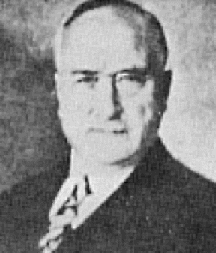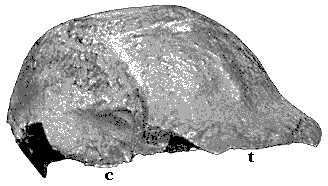|
.
The initial discovery of Homo erectus in 1891 was due to the single-minded
efforts of a Dutch physician, Eugene Dubois (fig.1), seeking evidence of
an ancestral “missing link” between apes and humans in the tropics
of southeast Asia.
While studying comparative anatomy in medical school in th e early 1880s,
Dubois read about the “missing link” concept of Ernst Haeckel (1868),
proposing a bipedal “ape-man” named Pithecanthropus alalus.
Determined to prove this theory by the discovery of Pithecanthropus
fossils, Dubois selected Indonesia based on Haeckel’s (mistaken) belief
that humans evolved most
directly from orangutans, today only found in Indonesia; and Alfred
Wallace’s view that the origins of modern humans might lie in Southeast
Asia. Yet the selection proved propitious and led to highly important discoveries
on human evolution. e early 1880s,
Dubois read about the “missing link” concept of Ernst Haeckel (1868),
proposing a bipedal “ape-man” named Pithecanthropus alalus.
Determined to prove this theory by the discovery of Pithecanthropus
fossils, Dubois selected Indonesia based on Haeckel’s (mistaken) belief
that humans evolved most
directly from orangutans, today only found in Indonesia; and Alfred
Wallace’s view that the origins of modern humans might lie in Southeast
Asia. Yet the selection proved propitious and led to highly important discoveries
on human evolution.
Fig.1: Eugene Dubois (1858-1940) in 1928.
Dubois obtained a hospital post in Sumatra where he began to search for early
Pleistocene fossils. Learning that Java provided more relevant geological
exposures, Dubois transferred there to explore sites in the east-central
portion of Java along the Solo River where fossils had been found by local
farmers. Test excavations in sandstone deposits at Trinil in 1891 first revealed
abundant fossils of extinct deer, elephants, and buffalo, and the molar of
an extinct chimpanzee Anthropopithecus. Chimps lived in Java during
the Pleistocene, bolstering the “missing link theory.
Then, in October
1891, Dubois found a fossilized skullcap (fig 2) of a large-brained higher
primate with a pinched-in region before the brain case (postorbital constriction;
c in fig.2) and thick brow ridges (supraorbital torii; t in  fig.2). At
first, calculating the brain size as only 700 cc, Dubois associated the skull
with the chimpanzee tooth found on the same level. The next year (1892),
when a human-like thigh bone (femur) came from the same Trinil deposits,
Dubois named the collective finds anthropithecus erectus, or “erect
man-ape.” fig.2). At
first, calculating the brain size as only 700 cc, Dubois associated the skull
with the chimpanzee tooth found on the same level. The next year (1892),
when a human-like thigh bone (femur) came from the same Trinil deposits,
Dubois named the collective finds anthropithecus erectus, or “erect
man-ape.”
. Fig.2: Trinil 2 skullcap of Pithecanthropus erectus, showing c)
postorbital constriction, and t) brow ridges or supraorbital torii.
After remeasuring the cranial capacity to 900 cc, however, Dubois changed
the name to Pithecanthropus erectus (“erect ape-man”), after
Haeckel’s term. The femur’s age remains uncertain, although it
is thicker than modern examples. To Dubois, the association of the obviously
early skull with the human-looking legbone, showing bipedal posture, provided
evidence of the missing link sought by many late 19th century evolutionists.
When Dubois published his find in 1894 it met with great resistence from
many scientists and the public. Eventually embittered, he locked the bones
in a trunk, and only revealed the Trinil skullcap in 1923 to Ales Hrdlicka
of the Smithsonian Institution. By the late 1930s the resemblance of the
Trinil skullcap to Chinese finds at Zhoukoudian became obvious, and
Pithecanthropus was reclassified as an early human (Homo).
Dubois, however, never accepted this, considering the Chinese fossils to
be “degenerate Neanderthals.”
None of this, however, clouds the importance of his 1891 Trinil discovery.
Dubois was correct in thinking he had found an early human ancestor. The
Trinil 2 skullcap (dated before 800,000 BP) is recognized as the type specimen
of Homo erectus.
References:
Shipman, P. 2001. The Man Who Found the Missing Link. New York, Simon
& Schuster.
Swisher, C.C., G.H. Curtis, and R. Lewin. 2000. Java Man. New York,
Scribner.
This article appears on page 15 in Vol.4, No.1 of Athena
Review.
.
|